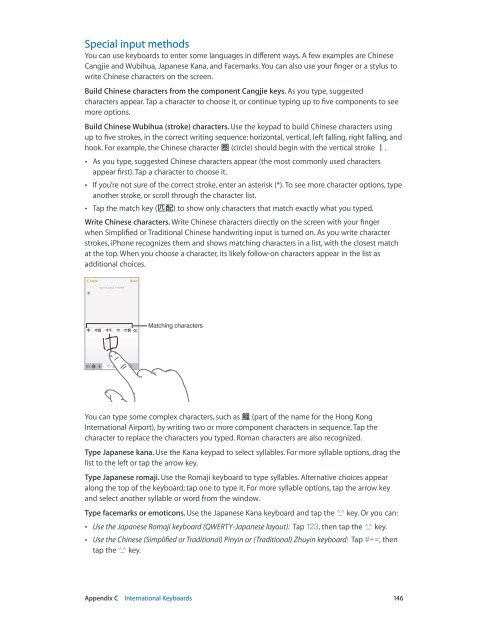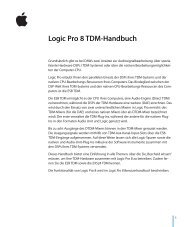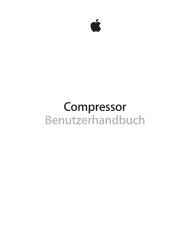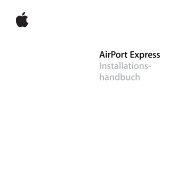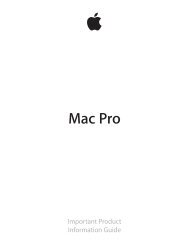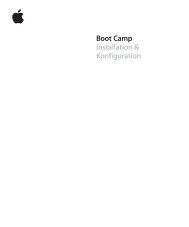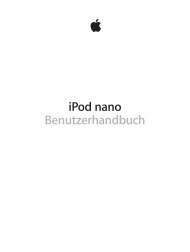iPhone User Guide - Support - Apple
iPhone User Guide - Support - Apple
iPhone User Guide - Support - Apple
Create successful ePaper yourself
Turn your PDF publications into a flip-book with our unique Google optimized e-Paper software.
Special input methods<br />
You can use keyboards to enter some languages in different ways. A few examples are Chinese<br />
Cangjie and Wubihua, Japanese Kana, and Facemarks. You can also use your finger or a stylus to<br />
write Chinese characters on the screen.<br />
Build Chinese characters from the component Cangjie keys. As you type, suggested<br />
characters appear. Tap a character to choose it, or continue typing up to five components to see<br />
more options.<br />
Build Chinese Wubihua (stroke) characters. Use the keypad to build Chinese characters using<br />
up to five strokes, in the correct writing sequence: horizontal, vertical, left falling, right falling, and<br />
hook. For example, the Chinese character 圈 (circle) should begin with the vertical stroke 丨 .<br />
••<br />
As you type, suggested Chinese characters appear (the most commonly used characters<br />
appear first). Tap a character to choose it.<br />
••<br />
If you’re not sure of the correct stroke, enter an asterisk (*). To see more character options, type<br />
another stroke, or scroll through the character list.<br />
••<br />
Tap the match key ( 匹 配 ) to show only characters that match exactly what you typed.<br />
Write Chinese characters. Write Chinese characters directly on the screen with your finger<br />
when Simplified or Traditional Chinese handwriting input is turned on. As you write character<br />
strokes, <strong>iPhone</strong> recognizes them and shows matching characters in a list, with the closest match<br />
at the top. When you choose a character, its likely follow-on characters appear in the list as<br />
additional choices.<br />
Matching characters<br />
You can type some complex characters, such as 鱲 (part of the name for the Hong Kong<br />
International Airport), by writing two or more component characters in sequence. Tap the<br />
character to replace the characters you typed. Roman characters are also recognized.<br />
Type Japanese kana. Use the Kana keypad to select syllables. For more syllable options, drag the<br />
list to the left or tap the arrow key.<br />
Type Japanese romaji. Use the Romaji keyboard to type syllables. Alternative choices appear<br />
along the top of the keyboard; tap one to type it. For more syllable options, tap the arrow key<br />
and select another syllable or word from the window.<br />
Type facemarks or emoticons. Use the Japanese Kana keyboard and tap the key. Or you can:<br />
••<br />
Use the Japanese Romaji keyboard (QWERTY-Japanese layout): Tap , then tap the key.<br />
••<br />
Use the Chinese (Simplified or Traditional) Pinyin or (Traditional) Zhuyin keyboard: Tap , then<br />
tap the key.<br />
Appendix C International Keyboards 146


